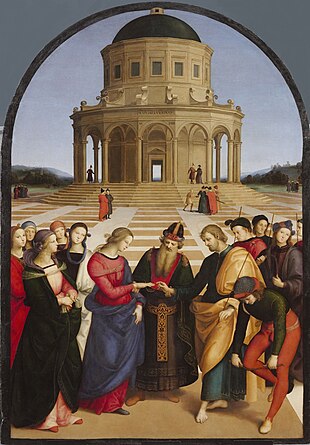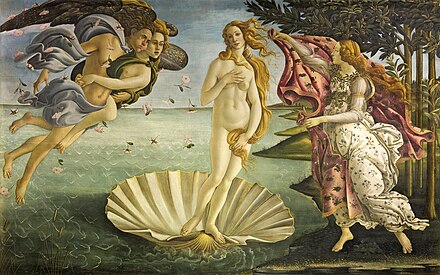
Italian Renaissance painting is the painting of the period beginning in the late 13th century and flourishing from the early 15th to late 16th centuries, occurring in the Italian Peninsula, which was at that time divided into many political states, some independent but others controlled by external powers. The painters of Renaissance Italy, although often attached to particular courts and with loyalties to particular towns, nonetheless wandered the length and breadth of Italy, often occupying a diplomatic status and disseminating artistic and philosophical ideas.[1]
The city of Florence in Tuscany is renowned as the birthplace of the Renaissance, and in particular of Renaissance painting, although later in the era Rome and Venice assumed increasing importance in painting. A detailed background is given in the companion articles Renaissance art and Renaissance architecture. Italian Renaissance painting is most often divided into four periods: the Proto-Renaissance (1300–1425), the Early Renaissance (1425–1495), the High Renaissance (1495–1520), and Mannerism (1520–1600). The dates for these periods represent the overall trend in Italian painting and do not cover all painters as the lives of individual artists and their personal styles overlapped these periods.
The Proto-Renaissance begins with the professional life of the painter Giotto and includes Taddeo Gaddi, Orcagna, and Altichiero. The Early Renaissance style was started by Masaccio and then further developed by Fra Angelico, Paolo Uccello, Piero della Francesca, Sandro Botticelli, Verrocchio, Domenico Ghirlandaio, and Giovanni Bellini. The High Renaissance period was that of Leonardo da Vinci, Michelangelo, Raphael, Andrea del Sarto, Coreggio, Giorgione, the latter works of Giovanni Bellini, and Titian. The Mannerist period, dealt with in a separate article, included the latter works of Michelangelo, as well as Pontormo, Parmigianino, Bronzino, and Tintoretto.

- ^ e.g. Antonello da Messina who travelled from Sicily to Venice via Naples.